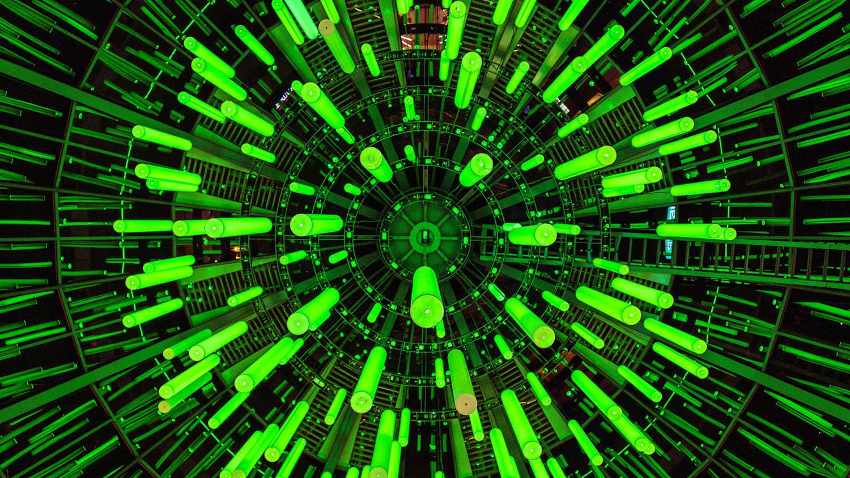Researchers have developed a technique to precisely control the structure of layered hybrid perovskites, paving the way for more efficient light-emitting devices.
Summary: Scientists at North Carolina State University have discovered a method to engineer layered hybrid perovskites at the atomic level, allowing unprecedented control over their light-emitting properties. This breakthrough could lead to significant advancements in LED and laser technologies.
Estimated reading time: 5 minutes
A team of researchers from North Carolina State University has made a significant advancement in the field of materials science, developing a technique to engineer layered hybrid perovskites (LHPs) with atomic precision. This breakthrough allows for exact control over how these materials convert electrical charge into light, opening up new possibilities for next-generation printed LEDs and lasers.
Understanding Layered Hybrid Perovskites
Perovskites are a class of materials defined by their crystalline structure. LHPs consist of extremely thin sheets of perovskite semiconductor material separated by organic “spacer” layers. These materials are particularly interesting due to their efficient conversion of electrical charge into light, making them promising candidates for advanced optoelectronic applications.
The Role of Quantum Wells and Nanoplatelets
The researchers discovered that the key to controlling LHP properties lies in understanding and manipulating quantum wells – sheets of semiconductor material sandwiched between spacer layers.
Aram Amassian, professor of materials science and engineering at NC State and corresponding author of the study, explains: “We knew quantum wells were forming in LHPs – they’re the layers.”
The team found that nanoplatelets, individual sheets of perovskite material forming on the solution surface, act as templates for the layered materials beneath them. This discovery resolved a long-standing anomaly in the field regarding discrepancies between X-ray diffraction and optical spectroscopy measurements of quantum well sizes.
Controlling Quantum Well Formation
By manipulating the growth of nanoplatelets, the researchers found they could control the size and distribution of quantum wells in LHP films. This level of control allows for the creation of efficient energy cascades, crucial for laser and LED applications.
“What’s exciting is that we found we can essentially stop the growth of nanoplatelets in a controlled way, essentially tuning the size and distribution of quantum wells in LHP films,” Amassian states.
Implications for Photovoltaic Technologies
The team’s findings extend beyond light-emitting applications. They discovered that nanoplatelets play a similar role in other perovskite materials used in solar cells and photovoltaic technologies.
Milad Abolhasani, ALCOA Professor of Chemical and Biomolecular Engineering at NC State and co-author of the paper, notes: “We found that the nanoplatelets play a similar role in other perovskite materials and can be used to engineer those materials to enhance the desired structure, improving their photovoltaic performance and stability.”
Potential Impact and Future Research
This research opens up new avenues for creating highly efficient and tailored materials for optoelectronic applications. The ability to precisely control the structure of LHPs at the atomic level could lead to significant improvements in the performance of LEDs, lasers, and solar cells.
Future research may focus on scaling up this technique for commercial applications and exploring its potential in other areas of materials science and engineering.
Quiz: Test Your Knowledge
- What are layered hybrid perovskites (LHPs) composed of?
- What role do nanoplatelets play in the formation of LHPs?
- How does controlling nanoplatelet growth affect quantum wells in LHP films?
Answers:
- LHPs consist of thin sheets of perovskite semiconductor material separated by organic spacer layers.
- Nanoplatelets act as templates for the layered materials that form beneath them.
- Controlling nanoplatelet growth allows for tuning the size and distribution of quantum wells in LHP films.
Glossary of Terms
- Perovskites: Materials defined by their specific crystalline structure, known for desirable optical and electronic properties.
- Layered Hybrid Perovskites (LHPs): Thin sheets of perovskite semiconductor material separated by organic spacer layers.
- Quantum Wells: Sheets of semiconductor material sandwiched between spacer layers in LHPs.
- Nanoplatelets: Individual sheets of perovskite material that form on the surface of the solution used to create LHPs.
- Energy Cascade: The flow of energy from high-energy structures to low-energy structures at the molecular level.
- X-ray Diffraction: A technique used to determine the atomic and molecular structure of a crystal.
For more information, read the full study published in Matter: https://doi.org/10.1016/j.matt.2024.09.010
Enjoy this story? Get our newsletter! https://scienceblog.substack.com/


